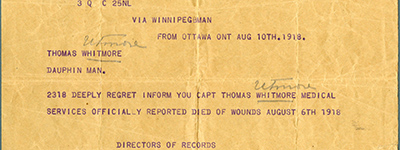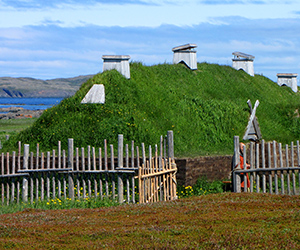CANADA HISTORY - Places-Settlements
Fort Garry

Fort Garry, established by the Hudson's Bay Company (HBC) in 1822 at the confluence of the Red and Assiniboine Rivers, played a pivotal role in the development of the Canadian West. Built to replace the Northwest Company’s old Fort Gibraltar, it became a symbol of the HBC’s dominance in the fur trade and later a focal point for the political upheavals that shaped Manitoba’s entry into Canadian Confederation. This essay explores the origins of Fort Garry, its role in the fur trade, its significance in the events surrounding the Métis leader Louis Riel, and its eventual transformation into the city of Winnipeg.
Origins of Fort Garry
Fort Garry was built at a time of intense competition between the Hudson’s Bay Company and the North West Company for control over the fur trade in western Canada. Located where the Red and Assiniboine Rivers meet, the fort’s position made it an ideal hub for the fur trade, as the rivers served as vital transportation routes for goods and supplies. Following the 1821 merger of the Hudson’s Bay Company and the North West Company, the HBC consolidated its hold on the region, and Fort Garry replaced Fort Gibraltar, the former trading post of its competitor.
The fort was named after Nicholas Garry, the Deputy Governor of the HBC, who played a key role in the merger of the two fur-trading giants. The construction of Fort Garry was emblematic of the HBC’s growing influence in the region, as it established a new base of operations to support its vast network of trading posts throughout the Northwest. Fort Garry quickly became a center of economic and social activity in the Red River Settlement, where Indigenous peoples, European settlers, and fur traders gathered to exchange goods.
Flooding and Reconstruction
Like many settlements along the Red and Assiniboine Rivers, Fort Garry was vulnerable to flooding. In 1826, the rivers overflowed their banks, inundating the surrounding region and destroying the fort. The devastation caused by the flood forced the HBC to abandon Fort Garry for nearly a decade. However, recognizing the strategic importance of the site, the company rebuilt the fort in 1835. This time, it became known as Upper Fort Garry, distinguishing it from Lower Fort Garry, which had been constructed downstream in 1831, about 32 kilometers north, as an additional trading post and supply depot.
Upper Fort Garry quickly reestablished itself as a major trading post and administrative center for the Hudson’s Bay Company. Its reconstruction was part of the broader expansion of the HBC’s operations in the West, as the company sought to strengthen its grip on the fur trade and secure its influence over the region’s Indigenous peoples and settlers. The new fort was larger and more fortified than its predecessor, with thick stone walls and defensive features that reflected its importance as a center of HBC power.
Upper Fort Garry and the Red River Rebellion
Fort Garry’s role shifted dramatically in 1870 during the Red River Rebellion, a pivotal moment in Canadian history that ultimately led to the creation of the province of Manitoba. At the heart of the conflict was the Hudson’s Bay Company’s decision to transfer control of Rupert’s Land (the vast territory surrounding the Red River Settlement) to the newly formed Dominion of Canada. The Métis, who had lived in the region for generations and had developed a distinct culture blending Indigenous and European traditions, feared that their land rights and way of life would be threatened by the influx of new settlers and the imposition of Canadian authority.
In response to these concerns, Métis leader Louis Riel and his followers occupied Upper Fort Garry in October 1869, effectively taking control of the fort and asserting Métis authority over the region. The occupation of the fort was a strategic move, as it allowed the Métis to control the flow of goods and supplies into the Red River Settlement and gave them a platform from which to negotiate with the Canadian government.
Riel’s provisional government, formed at Upper Fort Garry, sought to negotiate terms for the entry of the Red River Settlement into Confederation on equal footing with the other provinces of Canada. Their demands included the protection of Métis land rights, recognition of French and English as official languages, and the guarantee of religious and educational freedoms. These demands were ultimately enshrined in the Manitoba Act of 1870, which created the province of Manitoba and secured many of the rights sought by the Métis.
However, the occupation of Upper Fort Garry was not without consequences. The arrival of Canadian troops, sent to assert federal authority and restore order, led to tensions between the Métis and the Canadian government. Riel was forced to flee into exile, and although Manitoba was admitted to Confederation, the Métis found themselves increasingly marginalized as new settlers from Ontario flooded into the province.
The Decline of Upper Fort Garry and the Rise of Winnipeg
After the creation of Manitoba, Upper Fort Garry gradually lost its importance as a military and administrative center. By 1874, the growing settlement around the fort had evolved into the city of Winnipeg, which quickly overshadowed the fort as the hub of economic and political activity in the region. The construction of railways and the influx of new settlers transformed Winnipeg into a thriving metropolis, and Upper Fort Garry was largely abandoned.
Over time, much of the original fort was dismantled, and only the stone gate of Upper Fort Garry remains today as a historical landmark in downtown Winnipeg. The gate stands as a reminder of the fort’s central role in the early history of the Red River Settlement and its place in the dramatic events that shaped the formation of Manitoba.
Fort Garry’s Importance to Canada
The history of Fort Garry is deeply intertwined with the broader history of western Canada, particularly in terms of its role in the fur trade, Indigenous-settler relations, and the expansion of Canadian Confederation. As a key trading post for the Hudson’s Bay Company, the fort helped establish the economic foundations of the Red River Settlement and facilitated interactions between Indigenous peoples and European settlers.
Fort Garry’s occupation by Louis Riel and the Métis during the Red River Rebellion underscores its importance as a symbol of resistance to colonial authority and the fight for Indigenous and Métis rights. The events at Upper Fort Garry were instrumental in shaping the political landscape of Manitoba and ensuring that the Métis voice was heard during the negotiations that led to the province’s creation.
In the broader context of Canadian history, Fort Garry represents a turning point in the westward expansion of the country and the incorporation of vast new territories into the Dominion of Canada. The fort’s legacy endures not only in the surviving stone gate but also in the stories of the people who lived and worked there, from the fur traders and settlers to the Métis who fought to defend their land and culture.
Fort Garry’s history is one of resilience, adaptation, and transformation. From its origins as a key trading post in the fur trade to its central role in the Red River Rebellion, the fort has been at the heart of many of the major events that shaped the development of Manitoba and western Canada. While much of the original fort has been lost to time, the legacy of Fort Garry endures in the city of Winnipeg and in the historical memory of Canada. As a symbol of the struggles and triumphs of the people who lived on the Red River, Fort Garry remains an important part of Canada’s national heritage.
Cite Article : Reference: www.canadahistory.com/sections/documents/documents.html
Source: NA



